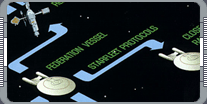
Long-Range Communications
Starfleet ships may be deep in space, but a sophisticated communications network allows them to keep
in contact with other vessels and never be entirely isolated.
 As part of their mission of exploration, Starfleet vessels regularly send message over enormous distances.
This is made possible by the use of a series of ultra-high power subspace transceivers that are normally
located just below the starship's hull. Vast amounts of information often have to be trafficked at
great speed, and a typical Starfleet vessel is designed to receive and transmit more than 18 kiloquads of
date per second.
As part of their mission of exploration, Starfleet vessels regularly send message over enormous distances.
This is made possible by the use of a series of ultra-high power subspace transceivers that are normally
located just below the starship's hull. Vast amounts of information often have to be trafficked at
great speed, and a typical Starfleet vessel is designed to receive and transmit more than 18 kiloquads of
date per second.
Subspace frequencies can carry electromagnetic signals at faster-than-light speeds and allow almost
instantaneous communications with distant locations. Under ideal circumstances, a subspace message has a
range of 22.65 light years, so transmissions are boosted by an interstellar network of subspace relay
stations after being sent. Subspace transceivers onboard ship are designed to function at both sublight
and warp velocities. Starship transceivers include both a sublight signal preprocessor and a warp
velocity signal preprocessor, an adapting antenna radiating element steering driver, a passive range
determinator, Heisenberg and Doppler compensators, and a signal cleaning and amplifying stage. Computers
automatically ensure that an incoming signal is as clear as possible, but personnel may need to make
manual adjustments. A typical ship-to-ship transmission is initiated when one ship sends a hailing
signal packet to another. The receiving ship's computers sense, decrypt, and verify the packet's
security protocols. The hailing packet then identifies the calling ship and supplies the data. A large
ship with hundreds of crew members is likely to receive an ongoing barrage of official and private
communiqués. All messages are automatically delivered to the proper terminus upon security
clearance. Many races and organizations other than the Federation have access to subspace technology;
to accommodate them the transceiver technology on Starfleet ships can be adjusted to interact with
previously unencountered protocols. When the main computer analyzes an alien language, it automatically
 activates the universal translator.
activates the universal translator.
Ship-to-starbase communications work in exactly the same way as between vessels. Contact with a starbase
can also trigger a data dump from starship to starbase containing details of ship operations, including
data collected, logs, hardware conditions, crew evaluations, and more. All this requires hundreds of
subspace channels. The data stream goes both ways, meaning the starship is able to receive mission orders
and condensed information from other starships.
|
|
"COMMUNICATIONS" - AUGUST 1999 ISSUE 4 STAR TREK: THE MAGAZINE COPYRIGHT OF PARAMOUNT PICTURES.
|